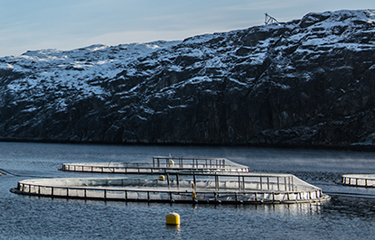Russian aquaculture firms are facing a shortage of aquafeed as Western suppliers become increasingly reluctant to sell products to Russian companies in response to the country’s invasion of Ukraine. In response, the Russian government is working to boost domestic production in an urgent attempt to fill supply gaps.
In 2021, Russia produced a record-high 358,000 metric tons (MT) of aquaculture products, a 180 percent increase from 2016. Of that total, 136,700 MT of the production was Atlantic salmon and char.
To achieve that growth in volume, Russia needed between an additional 200,000 and 230,000 MT of aquaculture feed, according to statistics from the Russian Federal Agency for Fisheries. As Russia only produced 20,000 MT of aquafeed domestically in 2021, an estimated 90 to 95 percent of the country’s aquafeed is imported.
Russia's government has pushed to boost domestic aquafeed production, supporting the development of several new feed plants now being constructed, but national manufacturers are still not close covering the Russian market’s aquafeed demand in either quantity or quality, according to Stanislav Bazhulin, the director of Lakhdenpokhya, Karelia-based aquaculture firm Lafor.
Bazhulin told Kommersant his farm had been buying products from Coppens, Skretting, and Raisio, but that he is now unable to purchase from any of them. Following the Ukraine invasion, most major foreign fish-feed manufacturers – including Denmark-based BioMar, Finland-based Raisio, and Norway-based Skretting – suspended all sales to Russia.
“The best producers are in Europe. They are owned by global corporations with access to the best resources. Russian producers cannot provide stable high-quality supplies. The quality of feed varies from batch to batch,” Bazhulin said. “And even if all Russian plants are fully loaded with orders, their capacities are not enough to cover the demand. We are open to all suppliers, and are now contacting companies from all over the world. We turned to China, Turkey, Iran, but we are not sure whether products from these countries will be good.”
With Russia's aquafeed inventory dwindling, a lack of feed is threatening to impact fish now in the water, and more broadly, the future prospects of the Russian aquaculture sector, Bazhulin said.
Farmers in Karelia, a region in Russia’s northwest which yields most of the country’s farmed char, told Kommersant they only have two months worth of aquafeed left. Companies and authorities are now urgently looking for supplier in Belarus, Iran, and Turkey, Karelian Agriculture and Fisheries Minister Vladimir Labinov told the paper. He said the region uses 50,000 MT of feed annually, 85 percent of which was previously imported from either Finland, Norway, or Denmark.
“A period of active feeding starts in late May, so we have only April and May for finding feed,” he said.
News agency Interfax talked with farmers in Russia’s Caucasus region, finding that fish farmers there are facing the same problem.
“We are looking for new feed as we’re experiencing difficulties with previous suppliers,” Soa-Fish Director Adalyat Ismailov told Interfax. “We are now choosing of the best Russian products and considering Turkish ones.”
Resurs Director Arsen Chomaev, also in the Caucasus, told Interfax that the price of feed has jumped 40 percent recently, translating into a 10 to 15 percent price increase for products at retail.
Russian aquaculture industry representatives are urging Russian Federal Agency for Fisheries authorities to act quickly to alleviate the problem. On 7 March, Russia Vice Premier Viktoria Abramchenko said the federal government will provide subsidies of up to 30 percent of the new cost of new aquafeed facilities. And Russian Federal Agency for Fisheries Head Ilya Shestakov said an existing industry program will be updated to more rapidly boost domestic production of aquaculture feed.
But even if new aquaculture feed production plants are built, they will take at least three years to come online, Shestakov said. For a short-term solution, he suggested the manufacturers of feed for other agricultural sectors could supply the aquaculture sector. Shestakov recently met with representatives of Russian agriculture feed firms, and according to the agency, received a warm welcome from manufacturers who expressed interest in finding new markets for their products.
The Russian Research Institute of Fisheries and Oceanography (VNIRO) said it is also ready to help. It said in a press release it is accelerating the establishment of a special competence center for aquaculture feed, and has worked for years to develop fish-feed formulations that will work for Russia's aquaculture industry. VNIRO said it has been cooperating with aquafeed start-ups that are poised to start scaling up their production.
“VNIRO’s scientific developments will make it possible to replace nearly all kinds of feed now imported,” an institute representative told Fishnews.
Photo courtesy of Russian Aquaculture







